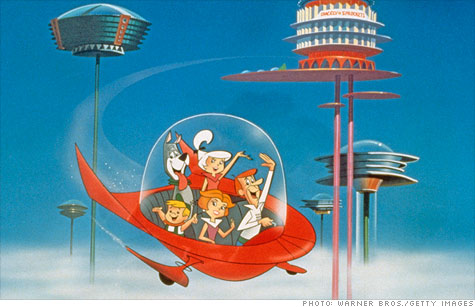Search News

Connected home technology, similar to The Jetsons, is finally ready.
BARCELONA, Spain (CNNMoney) -- In the classic 1960s animated sitcom The Jetsons, everything in the space-age family's home could be controlled by the press of a button on a remote control.
Fifty years later, that futuristic vision is finally becoming reality.
At Mobile World Congress this week, the wireless industry's largest annual convention, companies like AT&T (T, Fortune 500), Qualcomm (QCOM, Fortune 500), Intel (INTC, Fortune 500), and Sony (SNE) are showing off how everything in your home -- from your door locks to your thermostat to your TV -- can be controlled by a smartphone or tablet.
That kind of technology has been demonstrated and discussed for years, but it never graduated past a niche product for the uber rich and extremely geeky. Today, however, the hardware, software, and cloud-based infrastructure necessary to make it a reality is finally inexpensive enough for companies to bring full-home connectivity to the mainstream market.
But hold off on the excitement for a moment -- there's a sticking point. Connected-home technology won't become widespread until there's a uniform vision for how it will all work together.
There isn't one. Not yet.
AT&T on Monday unveiled its new home security platform, which allows security companies to sell automated home protection services. Using AT&T's network and software, a home security customer could control their heat, locks, lights, oven and security cameras using an iPad.
Intel featured a similar home-control technology, except instead of connecting devices through a wireless network, its system lets all the gadgets in the house talk to one another using what's known as machine-to-machine connections. Your window shades, dishwasher, refrigerator and other appliances would all link with a central router running the Linux operating system, which is connected to and controlled over the Internet.
Chipmaker Qualcomm showed off its new "Hy-Fi" platform, which lets consumers easily play media from any device on any other device in the home. Want to watch a movie on your TV that's stored on your iPad? A Hy-Fi router and receiver wired to your TV will take care of that. It also lets you listen to a song on your stereo that's stored on your hard drive.
Sony showed how you can dock a Sony smartphone, connect it to a Sony TV, and navigate your phone's media using your TV's remote. Or you can play a game on your PlayStation, and pick up where you left off on your portable PS Vita.
Each system has its own unique platform that is incompatible with everyone else's.
Without one clear standard for all in-home devices to talk to one another, consumers' choices are limited. You can either buy everything from the same brand (Sony's model), everything running the same platform (Intel and AT&T's models), or invest in additional hardware to connect all your existing stuff together (Qualcomm's model).
There are also other competing platforms that weren't at this year's Mobile World Congress.
Apple (AAPL, Fortune 500) has a home connectivity platform of its own, which allows Apple TV, Mac, iPhone and iPad users to stream and play content from any Apple device on the same network. Google (GOOG, Fortune 500) is in the process of unveiling its own standard called Android@Home, which would allow connected devices in your home to be powered by an Android smartphone or tablet.
There are advantages and disadvantages to each model.
Google and Intel have an open standard that any device maker can adopt for free. AT&T makes companies license its platform for a fee, but with that comes a representative that customers can yell at when things don't work. And Sony and Apple users don't have to purchase any extra technology -- just so long as they don't mind buying only Sony or Apple products.
Until one standard becomes universally accepted, The Jetsons vision will remain a fantasy. But with every major gadget maker pursuing it, it's now finally a fantasy backed up by impressive real-world demos. ![]()